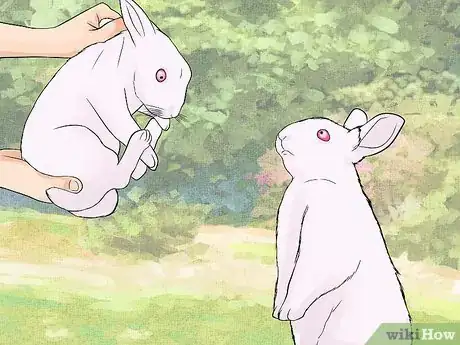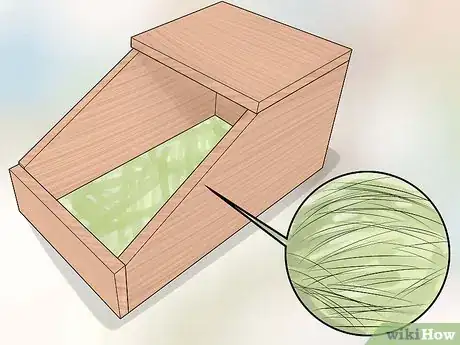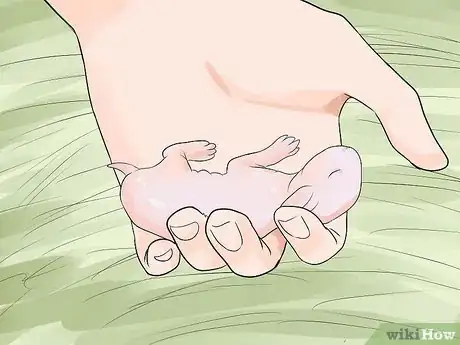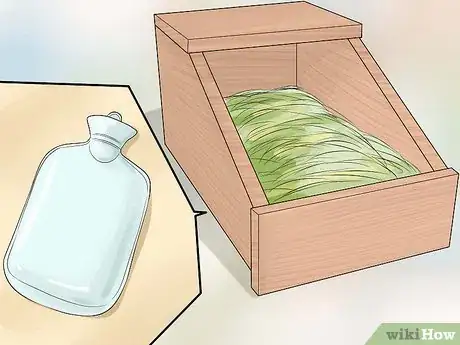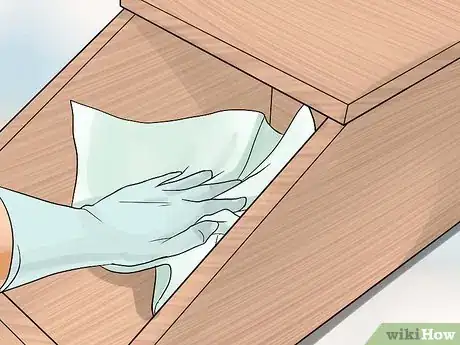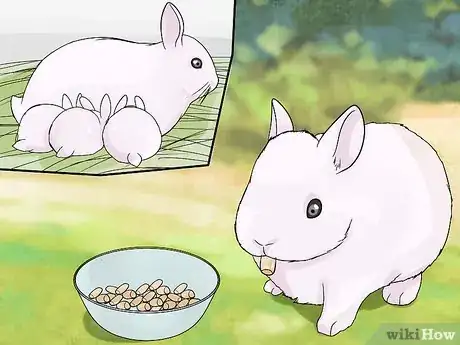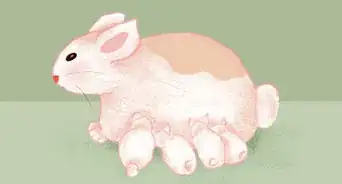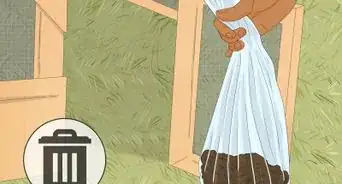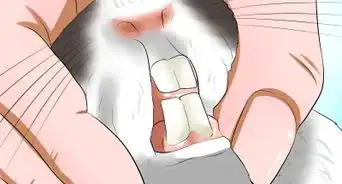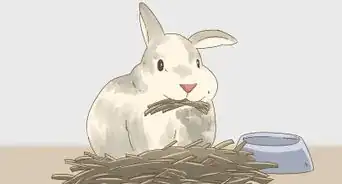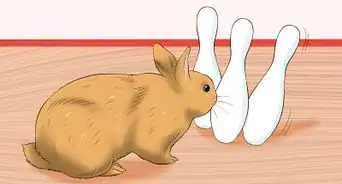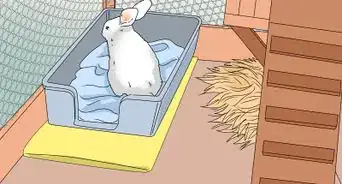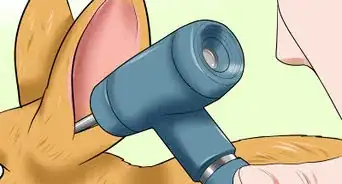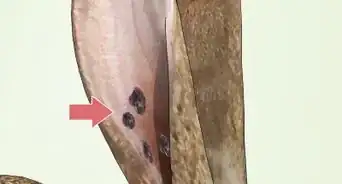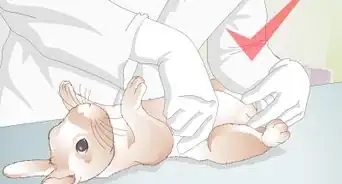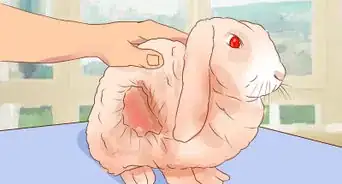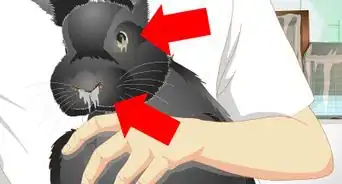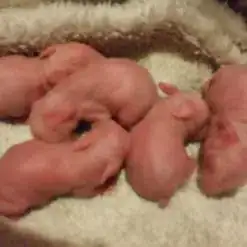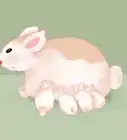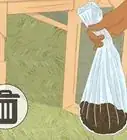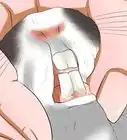This article was co-authored by Pippa Elliott, MRCVS. Dr. Elliott, BVMS, MRCVS is a veterinarian with over 30 years of experience in veterinary surgery and companion animal practice. She graduated from the University of Glasgow in 1987 with a degree in veterinary medicine and surgery. She has worked at the same animal clinic in her hometown for over 20 years.
There are 7 references cited in this article, which can be found at the bottom of the page.
wikiHow marks an article as reader-approved once it receives enough positive feedback. This article received 36 testimonials and 92% of readers who voted found it helpful, earning it our reader-approved status.
This article has been viewed 694,306 times.
So you found out or suspect that your female rabbit (or doe) is pregnant. Now what? You should know a few things in order to prepare the doe and her cage for the pregnancy, as well as how to help ensure the health of the newborn baby rabbits (or kits).
Steps
Preparing for the Arrival of the Newborn Rabbits
-
1Feed the mother a quality diet. Your rabbit’s diet will not vary much while she is pregnant or weaning, but it is as important as ever to provide high-quality nutrition. Check your feed label and provide a feed that is:
- 16 to 18 percent protein
- 18 to 22 percent fiber
- 3 percent or less in fat
- She should also have constant access to clean water, which you should change two to three times per day.
- You can supplement her diet while she is gestating and weaning the kits (babies) by giving her some alfalfa hay or cubes to provide more protein.[1]
-
2Separate her from the male rabbit. It is uncommon for the male rabbit to harm the kits. However, he can impregnate the female again as soon as she gives birth, resulting in another pregnancy before she finishes weaning the first litter. To avoid this, you should separate the two rabbits as birthing draws closer.[2]
- Ideally, you should keep the male close enough to make contact with the female through their separate enclosures. Rabbits bond very closely and still being close to the male will cut down on unnecessary stress for the female during the pregnancy and birth.[3]
Advertisement -
3Prepare a nest box. Kits are born without fur and will need constant warmth initially. Providing a nest box with bedding materials will help keep the kits warm and collected in one place. This small box (cardboard is fine) should be slightly larger than the mother with about a one-inch lip to stop the kits from getting away from the box.[4]
- Put a generous handful of grass (make sure no fertilizer or pesticides are present), straw, or hay in the box as well for bedding.[5] Put the bedding on top of a clean towel without any loose threads that might catch on the kits.[6]
- The female might rearrange the bedding in the box or even pull out some of her fur to add to the bedding, which is usually a sign that the birth is close.[7]
- Make sure you place the nesting box on the opposite side of the cage from the mother’s litter box to help avoid any complications for the kits.
- You should also place the cage in a quiet, darkened space. Too much activity around the mother and her new kits will cause her undue stress.[8]
Caring for the Newborn Rabbits
-
1Check the kits. The pregnancy for your doe will last roughly thirty-one to thirty-three days.[9] She doesn’t need any help with the birthing process, which usually happens at night or in the very early hours of the morning. This means you’ll likely wake up one morning to the new litter of kits. Immediately check to see if any of the kits did not survive the birth. You may have to draw the mother away with a treat to get access to the nest box to remove any of the dead kits.
- You should also remove any placenta or afterbirth from the box.
- Don’t be afraid of handling the babies as the mother will already be accustomed to your scent.
-
2Warm the kits if necessary. If the mother gave birth to any of the kits outside of the nesting box, then you’ll have to place them in the box. These kits will often be too cold and need warming. To do so safely, fill a hot water bottle with warm (not hot) water and place the bottle under the towel and bedding in the nesting box. The kits should not have direct contact with the bottle since this will likely be too warm.
-
3Provide the mother constant access to food and water. The doe will need constant access to food and water to eat at will while she’s nursing the kits.[10] This is to ensure she produces enough milk to adequately feed the litter. Put out plenty of fresh food daily and check her water often, as she’ll drink more more than normal as well.
- Ensuring that she receives proper nutrition will also help reduce the possibility of the mother cannibalizing the kits.
-
4Look for signs of nursing. The doe’s natural instinct is to stay away from the nest most of the time, so don’t be alarmed if you don’t actually see her nursing, which will only happen once or twice a day.[11] Instead, look for signs that she’s nursed. The babies will be warm and have round tummies from feeding.[12] They’ll also be quiet instead of making mewling noises like a kitten if they’re well fed.[13]
-
5Contact your vet immediately if the mother isn’t nursing. If the babies are weak (barely respond to being handled), have sunken tummies, and have wrinkly skin (caused by dehydration), then the mother isn’t properly nursing them, and you should see your vet immediately.
- If the mother set up the nesting box—especially if she pulled some of her fur—then she’s paying attention to her mothering instincts. The problem may be as simple as your vet providing a small dose of oxytocin to help with milk production.[14]
- You should also contact your vet if the litter is more than eight kits, as this may be too large a number for the mother to support all of them. If the mother has more than eight kits or she abandons the litter and will not nurse them, then your vet will likely provide instructions for bottle feeding the babies. However, results are often unsuccessful because there is no formula 100 percent adapted to newborn rabbits.
-
6Keep the nesting box clean. The babies will toilet in the box until they are strong enough to eventually climb out of it on there own, so you’ll need to clean the box daily, providing a new, dry bottom towel and clean bedding.
-
7Adapt the diet of the kits. The babies may begin nibbling at pellets as soon as two weeks after birth.[15] However, they should not stop nursing for a full eight weeks after they’re born.[16] During this period, the babies will slowly decrease nursing and increase their consumption of pellets, but it’s important that they continue to nurse as well as the mother’s milk provides antibodies against pathogens.[17] If they are weaned too soon, their immune systems might not yet be strong enough without these antibodies.
- You should additionally avoid feeding the rabbits greens for several months due to the potential for digestive complications. You can try tiny bits of one item at a time starting around two months, but remove it from the rabbit’s diet immediately if it causes intestinal problems such as diarrhea.[18] Good items to start with include carrots, romaine lettuce, and kale.[19]
-
8Handle the babies beginning at eight weeks. Until they’re weaned, the babies will be highly susceptible to illness and bacteria, especially E. coli, which can kill a kit in a matter of hours.[20] You should thoroughly wash your hands anytime that you need to handle the babies until they’re weaned. After that, try to handle them often because it will lead to tamer adult rabbits down the line.
Expert Q&A
Did you know you can get premium answers for this article?
Unlock premium answers by supporting wikiHow
-
QuestionShould we let mamma rabbit out of the cage for a break away from the babies?
 Pippa Elliott, MRCVSDr. Elliott, BVMS, MRCVS is a veterinarian with over 30 years of experience in veterinary surgery and companion animal practice. She graduated from the University of Glasgow in 1987 with a degree in veterinary medicine and surgery. She has worked at the same animal clinic in her hometown for over 20 years.
Pippa Elliott, MRCVSDr. Elliott, BVMS, MRCVS is a veterinarian with over 30 years of experience in veterinary surgery and companion animal practice. She graduated from the University of Glasgow in 1987 with a degree in veterinary medicine and surgery. She has worked at the same animal clinic in her hometown for over 20 years.
Veterinarian Yes. Mother rabbits often leave their young for hours at a time, so she will appreciate the opportunity to take a break. Just make sure that she can access the cage and return to her babies whenever she wants to. Try leaving the cage door open and provide a ramp for the mother rabbit so that she can return when she is ready.
Yes. Mother rabbits often leave their young for hours at a time, so she will appreciate the opportunity to take a break. Just make sure that she can access the cage and return to her babies whenever she wants to. Try leaving the cage door open and provide a ramp for the mother rabbit so that she can return when she is ready. -
QuestionShould I hand-rear baby rabbits if the mother ignores them?
 Pippa Elliott, MRCVSDr. Elliott, BVMS, MRCVS is a veterinarian with over 30 years of experience in veterinary surgery and companion animal practice. She graduated from the University of Glasgow in 1987 with a degree in veterinary medicine and surgery. She has worked at the same animal clinic in her hometown for over 20 years.
Pippa Elliott, MRCVSDr. Elliott, BVMS, MRCVS is a veterinarian with over 30 years of experience in veterinary surgery and companion animal practice. She graduated from the University of Glasgow in 1987 with a degree in veterinary medicine and surgery. She has worked at the same animal clinic in her hometown for over 20 years.
Veterinarian Where possible let the mother rabbit take care of the babies, as hand-rearing a rabbit is fraught with problems. Be aware that the mother only feeds her babies twice a day and she may well leave them unattended for long periods in between. Thus, although the babies may appear abandoned, if the mother can still get back to them the chances are they are not in difficulties. If you know the mother is dead, then feed twice a day (as she would) to tide them over until they are two to three weeks of age, when they start eating solid foods.
Where possible let the mother rabbit take care of the babies, as hand-rearing a rabbit is fraught with problems. Be aware that the mother only feeds her babies twice a day and she may well leave them unattended for long periods in between. Thus, although the babies may appear abandoned, if the mother can still get back to them the chances are they are not in difficulties. If you know the mother is dead, then feed twice a day (as she would) to tide them over until they are two to three weeks of age, when they start eating solid foods. -
QuestionWhen is the best time to start training your baby rabbits to use the litter box?
 Pippa Elliott, MRCVSDr. Elliott, BVMS, MRCVS is a veterinarian with over 30 years of experience in veterinary surgery and companion animal practice. She graduated from the University of Glasgow in 1987 with a degree in veterinary medicine and surgery. She has worked at the same animal clinic in her hometown for over 20 years.
Pippa Elliott, MRCVSDr. Elliott, BVMS, MRCVS is a veterinarian with over 30 years of experience in veterinary surgery and companion animal practice. She graduated from the University of Glasgow in 1987 with a degree in veterinary medicine and surgery. She has worked at the same animal clinic in her hometown for over 20 years.
Veterinarian It is easier to litter-train an older rabbit than a youngster, because the latter's attention span is limited. That said, even young rabbits tend to use one corner of the hutch to toilet in, so you can put a tray there as soon as the kits start to be more independent and move away from their mother - just don't expect too much too soon.
It is easier to litter-train an older rabbit than a youngster, because the latter's attention span is limited. That said, even young rabbits tend to use one corner of the hutch to toilet in, so you can put a tray there as soon as the kits start to be more independent and move away from their mother - just don't expect too much too soon.
References
- ↑ http://florida4h.org/projects/rabbits/MarketRabbits/Activity5_Requirements2.html
- ↑ http://www.bio.miami.edu/hare/surpriselitter.html
- ↑ http://www.bio.miami.edu/hare/surpriselitter.html
- ↑ http://www.rabbit.org/care/babies.html
- ↑ http://www.rabbit.org/care/babies.html
- ↑ http://www.bio.miami.edu/hare/surpriselitter.html
- ↑ http://www.bio.miami.edu/hare/surpriselitter.html
- ↑ http://www.bio.miami.edu/hare/surpriselitter.html
- ↑ http://www.merckvetmanual.com/pethealth/exotic_pets/rabbits/breeding_and_reproduction_of_rabbits.html
- ↑ http://florida4h.org/projects/rabbits/MarketRabbits/Activity5_Requirements2.html
- ↑ http://www.bio.miami.edu/hare/surpriselitter.html
- ↑ http://www.bio.miami.edu/hare/surpriselitter.html
- ↑ http://www.hrschicago.org/caring-for-the-newborn-rabbit/
- ↑ http://www.rabbit.org/care/babies.html
- ↑ http://www.bio.miami.edu/hare/surpriselitter.html
- ↑ http://www.bio.miami.edu/hare/surpriselitter.html
- ↑ http://www.bio.miami.edu/hare/surpriselitter.html
- ↑ http://www.bio.miami.edu/hare/diet.html
- ↑ http://www.bio.miami.edu/hare/diet.html
- ↑ http://www.bio.miami.edu/hare/poop.html
About This Article
To care for newborn rabbits, make sure they're nursing from their mother for the first 8 weeks after they're born. If they're not nursing, contact a vet immediately so they can help. Also, start to introduce pellet food 2 weeks after the rabbits are born so they start to wean off of milk. Try to handle the newborn rabbits as little as possible during the first 8 weeks. After 8 weeks, you can handle them as much as you'd like so they get used to you. For more tips, like how to take care of a mother rabbit after its kits are born, keep reading!

